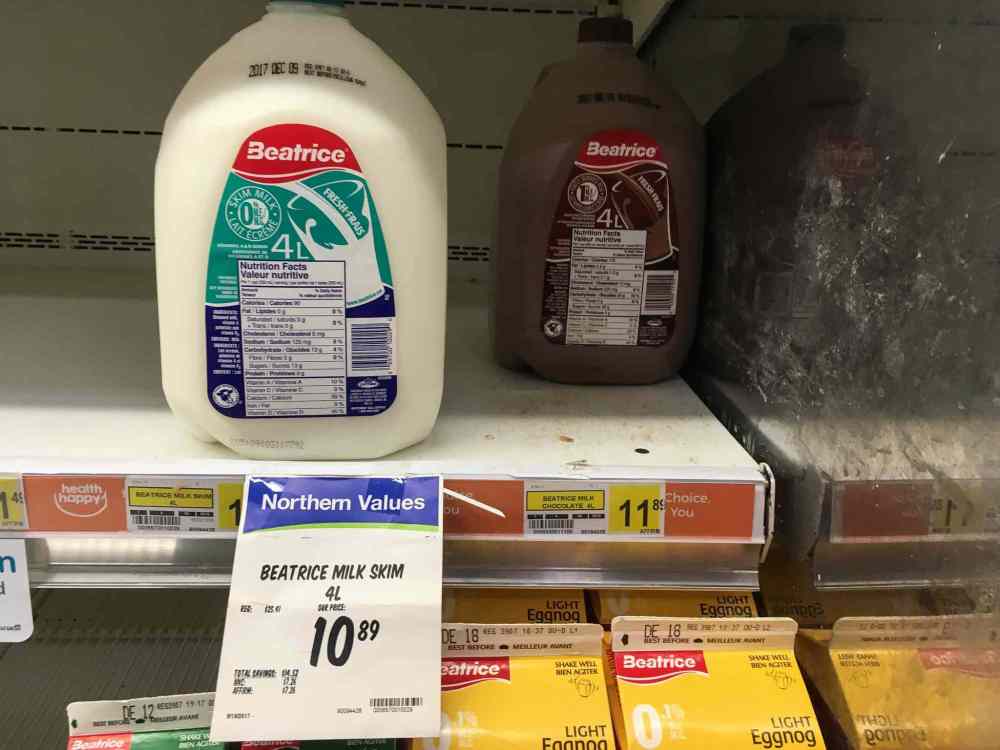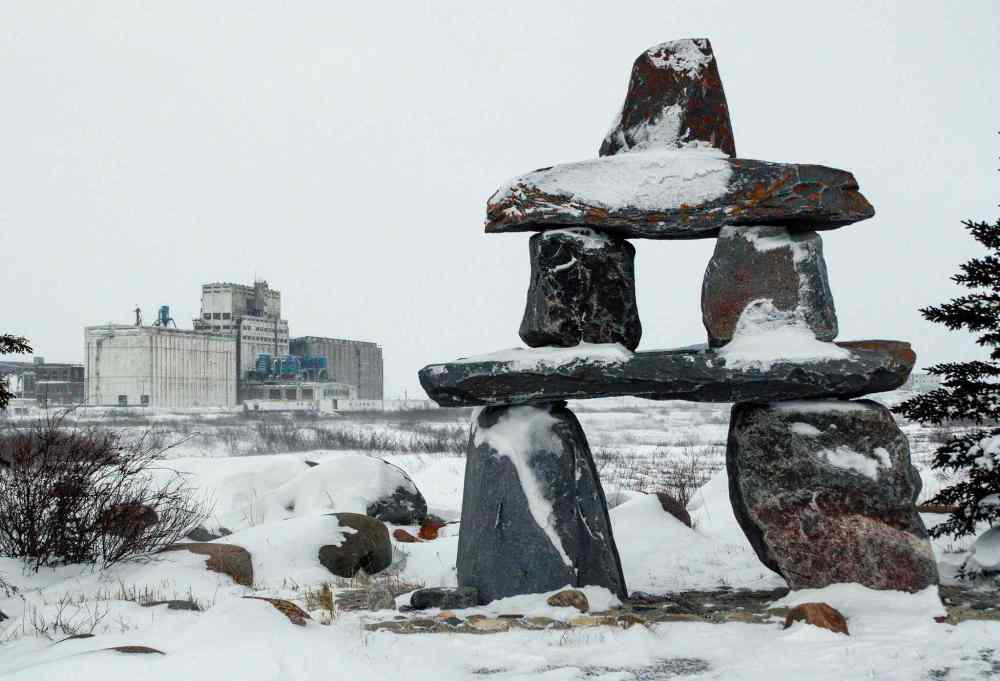Cold shoulder The harsh, unforgiving conditions are a given, but seven months after losing their rail lifeline, Churchill's isolated residents wonder if anyone cares
Read this article for free:
or
Already have an account? Log in here »
To continue reading, please subscribe:
Monthly Digital Subscription
$19 $0 for the first 4 weeks*
- Enjoy unlimited reading on winnipegfreepress.com
- Read the E-Edition, our digital replica newspaper
- Access News Break, our award-winning app
- Play interactive puzzles
*No charge for 4 weeks then billed as $19 every four weeks (new subscribers and qualified returning subscribers only). Cancel anytime.
Read unlimited articles for free today:
or
Already have an account? Log in here »
Hey there, time traveller!
This article was published 14/12/2017 (2323 days ago), so information in it may no longer be current.
Churchill has long been known for polar bears, beluga whales and northern lights. But since spring floods washed out its only overland link to the south last May, the town’s struggle to survive has dominated the news. Winnipeg Free Press Ottawa reporter Dylan Robertson travelled to Churchill last week and spent a day taking a look at how worn-out and worried residents are coping.
Churchill, 9:30 a.m.
Gusts of powdery snow block out the sunrise, as laid-off railway worker Floyd Saunders sips a cup of tea at his kitchen table.
Saunders was hired by the Hudson Bay Railway in 2007. When overland spring flooding washed out sections of track May 23, he says he wasn’t surprised.
“It wasn’t that bad when I first started,” he says. “But things started to decline.”
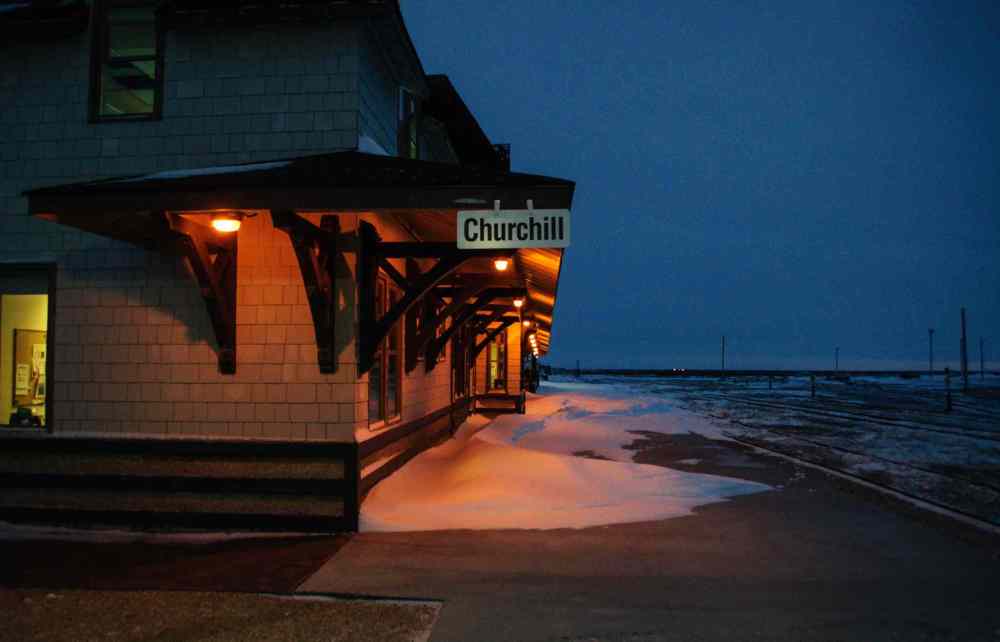
He recalls seeing faults in the line. When one rail rose three inches above the other, his team would correct it, but only by half an inch. Grooves appeared in parts of the line, but it was smooth enough for the test cars. Supervisors told him to patch up the line with old or mismatched bolts.
“It’s not a good feeling to go work with second-hand stuff, and that you never know if it’s going to break and hurt you,” he says, tugging on his baseball cap. “It just makes me feel, you know, not cared for.”
Down the hall in the bedroom, his wife Maria shushes three yelping dogs.
Since 1931, the Port of Churchill has sent Prairie grain around the world through summer seasons, allowing ships to cut weeks off trips beginning on the other two coasts.
The railway was completed two years earlier. It was supposed to terminate near York Factory, before officials realized the trading post to the south couldn’t handle deep-sea vessels.
Instead, the railway curves north at Gillam, cruising over interlocking ballast rock that sits atop muskeg and permafrost, effectively a frozen sponge.
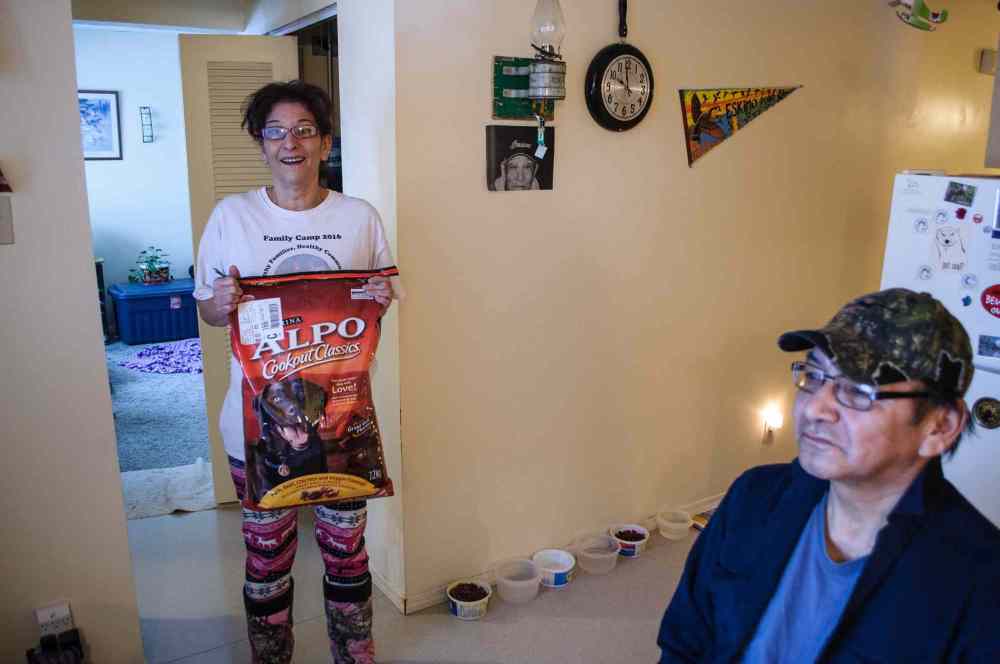
For decades, Saunders’ family helped keep the line running. His Cree relatives took pride in the work they did.
CN Rail operated the line until 1997, when Ottawa transferred the railway and port to Denver-based Omnitrax. It was a stable investment, with the federal Wheat Board monopoly sending Prairie grain up Omnitrax’s line and into its towering grain elevator.
In 2008, after years of unreliable service and derailments, the federal government and the province pledged $20 million each to repair the line.
The result, Saunders says, was overworked maintenance staff doing the bare minimum.
“They go out of their way to preach safety, and they’re the very first ones to break their rules and regulations, and I’ve seen that lots of times,” he says.
Omnitrax’s chief commercial officer disputes Saunders’ recounting.
“Since Omnitrax Canada acquired the line in 1997, the Hudson Bay Railway has met or exceeded Transport Canada standards. It is inspected and certified by Transport Canada annually,” Peter Touesnard wrote in an email.
“This year, prior to the catastrophic flooding, a senior Transport Canada official told Omnitrax Canada during a face-to-face meeting that the line was in the best condition he’d seen to date.”
Churchill lost its collective footing in 2012, when Ottawa dissolved the wheat board monopoly. Shippers signed contracts with more reliable ports. When stimulus money ran out in 2016, Omnitrax laid off almost all the facility’s workers.
Then in March, a historic three-day snowfall buried the town and its surrounding area. A rapid May melt flooded sections of the line north of Gillam, with 22 washouts and five damaged bridges. Within weeks, Omnitrax said it would not repair the line, as it was “not economically viable.”
It has sat still since, while Omnitrax, the province and Ottawa point fingers at each over who should pay the estimated $43.5 million cost of repairing the line, which can’t happen until spring at the earliest.
Food costs have since spiked in this town of 900, and Saunders knows families who have moved south.
His wife pulls out a $38 bag of Purina dog food, which sells for less than half that price in Winnipeg. She’s meticulously kept track of media reports and pushed officials to find a solution.
“It is insane,” she says, shaking the sack of kibble. “And people here are afraid to say anything, because nothing’s happening.
“We’re pawns.”
Things could have been different, Floyd believes.
“I know for a fact that line could have been fixed before freeze-up,” he says with a sigh. “I’ve done washouts before; they take a day at the most.”
Omnitrax eliminated Saunders’ position in October. His seniority allows him to bump someone with less experience from a job on the functioning part of the line to the south, but the company is also cutting back service and jobs in Thompson and The Pas.
Two Manitoba groups have separately tried taking over the rail line and port, with one bid dating back two years. Earlier this fall, Ottawa had them merge forces and kicked off talks aimed at transferring ownership.
Since then, there have been hints suggesting a deal was imminent, but there was no concrete progress. In early October, sources close to the transfer talks said negotiations broke down on the cusp of a major step toward signing a deal. And then, last month, a multimillion-dollar Toronto investment firm “expressed interest in partnering” with the now-unified group.
The dogs start barking again and Maria goes to let them out. Instead, they gather at Floyd’s feet, but he ignores them and stares out the window, wondering whether politicians in Ottawa and Winnipeg care about the people living in his town.
“Right now I feel like they’re not doing anything at all, other than talk,” he says. “It would be great to have a company to take it over; I’d be the first to come back.”
The flooding and the damage done
ILLUSTRATION: GRAEME BRUCE / WINNIPEG FREE PRESS
(function() {
var paidAccessCheck = function(){
if($(“.paidaccess”).css(“display”) == “block”){
var elements = Array.prototype.slice.call(document.querySelectorAll(“.g-artboard[data-min-width]”)),
widthById = {};
elements.forEach(function(el) {
var parent = el.parentNode,
width = widthById[parent.id] || parent.getBoundingClientRect().width,
minwidth = el.getAttribute(“data-min-width”),
maxwidth = el.getAttribute(“data-max-width”);
widthById[parent.id] = width;
if (+minwidth = width || maxwidth === null)) {
el.style.display = “block”;
} else {
el.style.display = “none”;
}
});
try {
if (window.parent && window.parent.$) {
window.parent.$(“body”).trigger(“resizedcontent”, [window]);
}
if (window.require) {
require([‘foundation/main’], function() {
require([‘shared/interactive/instances/app-communicator’], function(AppCommunicator) {
AppCommunicator.triggerResize();
});
});
}
} catch(e) { console.log(e); }
clearInterval(verifyPaidAccess);
}
}
var verifyPaidAccess = setInterval(paidAccessCheck,500);
// only want one resizer on the page
if (document.documentElement.className.indexOf(“g-resizer-v3-init”) > -1) return;
document.documentElement.className += ” g-resizer-v3-init”;
// require IE9+
if (!(“querySelector” in document)) return;
function resizer() {
var elements = Array.prototype.slice.call(document.querySelectorAll(“.g-artboard[data-min-width]”)),
widthById = {};
elements.forEach(function(el) {
var parent = el.parentNode,
width = widthById[parent.id] || parent.getBoundingClientRect().width,
minwidth = el.getAttribute(“data-min-width”),
maxwidth = el.getAttribute(“data-max-width”);
widthById[parent.id] = width;
if (+minwidth = width || maxwidth === null)) {
el.style.display = “block”;
} else {
el.style.display = “none”;
}
});
try {
if (window.parent && window.parent.$) {
window.parent.$(“body”).trigger(“resizedcontent”, [window]);
}
if (window.require) {
require([‘foundation/main’], function() {
require([‘shared/interactive/instances/app-communicator’], function(AppCommunicator) {
AppCommunicator.triggerResize();
});
});
}
} catch(e) { console.log(e); }
}
document.addEventListener(‘DOMContentLoaded’, resizer);
// feel free to replace throttle with _.throttle, if available
window.addEventListener(‘resize’, throttle(resizer, 200));
function throttle(func, wait) {
// from underscore.js
var _now = Date.now || function() { return new Date().getTime(); },
context, args, result, timeout = null, previous = 0;
var later = function() {
previous = _now();
timeout = null;
result = func.apply(context, args);
if (!timeout) context = args = null;
};
return function() {
var now = _now(), remaining = wait – (now – previous);
context = this;
args = arguments;
if (remaining wait) {
if (timeout) {
clearTimeout(timeout);
timeout = null;
}
previous = now;
result = func.apply(context, args);
if (!timeout) context = args = null;
} else if (!timeout && options.trailing !== false) {
timeout = setTimeout(later, remaining);
}
return result;
};
}
})();
.g-explain_text, .g-city-name, .g-park-name, .g-water-name, .g-aiPstyle5 {
text-shadow: -3px -3px 1px rgba(255, 255, 255, 0.4), -1px 1px 1px rgba(255, 255, 255, 0.4), -3px -1px 1px rgba(255, 255, 255, 0.4), -3px 0px 1px rgba(255, 255, 255, 0.4), -3px 1px 1px rgba(255, 255, 255, 0.4), -3px 2px 1px rgba(255, 255, 255, 0.4), -3px 3px 1px rgba(255, 255, 255, 0.4), -2px -3px 1px rgba(255, 255, 255, 0.4), -2px -2px 1px rgba(255, 255, 255, 0.4), -2px -1px 1px rgba(255, 255, 255, 0.4), -2px 0px 1px rgba(255, 255, 255, 0.4), -2px 1px 1px rgba(255, 255, 255, 0.4), -2px 2px 1px rgba(255, 255, 255, 0.4), -2px 3px 1px rgba(255, 255, 255, 0.4), -1px -3px 1px rgba(255, 255, 255, 0.4), -1px -2px 1px rgba(255, 255, 255, 0.4), -2px 3px 1px rgba(255, 255, 255, 0.4), -1px 0px 1px rgba(255, 255, 255, 0.4), -1px 1px 1px rgba(255, 255, 255, 0.4), -1px 2px 1px rgba(255, 255, 255, 0.4), -1px 3px 1px rgba(255, 255, 255, 0.4), 0px -3px 1px rgba(255, 255, 255, 0.4), 0px -2px 1px rgba(255, 255, 255, 0.4), 0px -1px 1px rgba(255, 255, 255, 0.4), 0px 1px 1px rgba(255, 255, 255, 0.4), 0px 2px 1px rgba(255, 255, 255, 0.4), 0px 3px 1px rgba(255, 255, 255, 0.4), 1px -3px 1px rgba(255, 255, 255, 0.4), 1px -2px 1px rgba(255, 255, 255, 0.4), 1px -1px 1px rgba(255, 255, 255, 0.4), 1px 0px 1px rgba(255, 255, 255, 0.4), 1px 1px 1px rgba(255, 255, 255, 0.4), 1px 2px 1px rgba(255, 255, 255, 0.4), 1px 3px 1px rgba(255, 255, 255, 0.4), 2px -3px 1px rgba(255, 255, 255, 0.4), 2px -2px 1px rgba(255, 255, 255, 0.4), 2px -1px 1px rgba(255, 255, 255, 0.4), 2px 0px 1px rgba(255, 255, 255, 0.4), 2px 1px 1px rgba(255, 255, 255, 0.4), 2px 2px 1px rgba(255, 255, 255, 0.4), 2px 3px 1px rgba(255, 255, 255, 0.4), 3px -3px 1px rgba(255, 255, 255, 0.4), 3px -2px 1px rgba(255, 255, 255, 0.4), 3px -1px 1px rgba(255, 255, 255, 0.4), 3px 0px 1px rgba(255, 255, 255, 0.4), 3px 1px 1px rgba(255, 255, 255, 0.4), 3px 2px 1px rgba(255, 255, 255, 0.4), 3px 3px 1px rgba(255, 255, 255, 0.4);
}
.g-park-name, .g-water-name {
opacity: .2;
font-style: italic;
}
.g-artboard {
margin:0 auto;
}
position:relative;
overflow:hidden;
width:630px;
}
.g-aiAbs{
position:absolute;
}
.g-aiImg{
display:block;
width:100% !important;
}
#g-map-new-new-mediumlarge_artboard p{
font-family:nyt-franklin,arial,helvetica,sans-serif;
font-size:13px;
line-height:18px;
margin:0;
}
#g-map-new-new-mediumlarge_artboard .g-aiPstyle0 {
font-size:50px;
line-height:60px;
text-align:right;
filter: alpha(opacity=50);
-ms-filter:’progid:DXImageTransform.Microsoft.Alpha(Opacity=50)’;
opacity:0.5;
color:#000000;
}
#g-map-new-new-mediumlarge_artboard .g-aiPstyle1 {
font-family:Open Sans,sans-serif;
font-size:22px;
line-height:26px;
font-weight:300;
color:#000000;
}
#g-map-new-new-mediumlarge_artboard .g-aiPstyle2 {
font-family:Open Sans,sans-serif;
font-size:30px;
line-height:36px;
font-weight:700;
color:#000000;
}
#g-map-new-new-mediumlarge_artboard .g-aiPstyle3 {
font-size:15px;
text-align:center;
color:#000000;
}
#g-map-new-new-mediumlarge_artboard .g-aiPstyle4 {
font-family:Open Sans,sans-serif;
font-size:19px;
line-height:22px;
font-weight:300;
color:#000000;
}
#g-map-new-new-mediumlarge_artboard .g-aiPstyle5 {
line-height:15px;
text-align:center;
color:#000000;
}
#g-map-new-new-mediumlarge_artboard .g-aiPstyle6 {
font-family:Open Sans,sans-serif;
font-size:19px;
line-height:22px;
font-weight:300;
text-align:right;
color:#000000;
}
#g-map-new-new-mediumlarge_artboard .g-aiPstyle7 {
font-family:Open Sans,sans-serif;
font-size:18px;
line-height:21px;
font-weight:300;
color:#000000;
}
#g-map-new-new-mediumlarge_artboard .g-aiPstyle8 {
font-family:Open Sans,sans-serif;
font-size:26px;
line-height:31px;
font-weight:700;
color:#000000;
}
#g-map-new-new-mediumlarge_artboard .g-aiPstyle9 {
font-family:Open Sans,sans-serif;
font-size:26px;
line-height:31px;
font-weight:700;
text-align:right;
color:#000000;
}
#g-map-new-new-mediumlarge_artboard .g-aiPstyle10 {
font-family:Open Sans,sans-serif;
font-size:21px;
line-height:26px;
font-weight:300;
text-align:center;
color:#808080;
}
.g-aiPtransformed p { white-space: nowrap; }

↑N
Churchill has been without a ground link to the south since May 23, 2017, when heavy flooding knocked out the rail line near Gillam. Even with a northern food subsidy, a jug of milk jumped to over $10 over the summer; gas now costs more than $2 per litre and the tourism industry is under strain, after Via Rail removed its stranded locomotives.
Churchill
Hudson Bay
The Port of Churchill’s owner, Omnitrax, laid off 90 workers in July 2016, ending almost all port operations.
Wapusk National Park
Polar Industries has partnered with Fox Lake Cree Nation to haul freight from Gillam to Churchill via an ice road. The road was scheduled to open on Dec. 17.
Washout (22)
Impassable bridge (5)
Unstable area (3)
It would cost $43.5 million to repair this 80-km stretch within 60 days, according to a consultant’s report. Omnitrax won’t pay for the repairs, saying the line is "not economically viable." Transport Canada filed an$18.8-million lawsuit to claw back the funds Ottawa provided under a 2008 agreement to improve the line.
Gillam
Meanwhile, Omnitrax says it would sue the government for $150 million if arbitration doesn’t result in a settlement that sees the railway repaired and transferred alongside the port for a negotiated amount.
A group of First Nation chiefs and municipalities along the line announced in September the intention to purchase the rail line and port and to "engage the governments of Canada and Manitoba" regarding the rail repairs, but no repairs have been done.
There are no all-season roads north past Gillam.
Thompson
Paint Lake
The impact of the rail closure is not contained to just Churchill. Citing a decline in rail demand stemming from a lack of service further up the line, Omnitrax halved fuel delivery to Thompson in the fall. Niki Ashton, the region’s MP, says a lack of fuel trucks heading into the winter season puts lives at risk.
The line has been an issue since it was first conceived in the late 1800s. A few years after construction began, CN took it over in 1920, extending the project to Churchill. Omnitrax took over in 1997. In 2008, the federal and provincial governments poured in $40 million for rail upgrades.
A copper and zinc mine in Flin Flon relies on line for shipments to The Pas before it’s transfered to CN.
A fire in April 2017 caused $1M worth of damage to the Hudson Bay rail yard in The Pas. 12,000 rail ties for repairs up the line were lost.
Flin Flon
Grass River
Provincial Park
SASKATCHEWAN
The Pas
Cedar Lake
position:relative;
overflow:hidden;
width:300px;
}
.g-aiAbs{
position:absolute;
}
.g-aiImg{
display:block;
width:100% !important;
}
#g-map-new-new-mediumsmall_artboard p{
font-family:nyt-franklin,arial,helvetica,sans-serif;
font-size:13px;
line-height:18px;
margin:0;
}
#g-map-new-new-mediumsmall_artboard .g-aiPstyle0 {
font-size:22px;
line-height:26px;
text-align:right;
filter: alpha(opacity=50);
-ms-filter:’progid:DXImageTransform.Microsoft.Alpha(Opacity=50)’;
opacity:0.5;
color:#000000;
}
#g-map-new-new-mediumsmall_artboard .g-aiPstyle1 {
font-family:Open Sans,sans-serif;
font-size:12px;
line-height:14px;
font-weight:300;
color:#000000;
}
#g-map-new-new-mediumsmall_artboard .g-aiPstyle2 {
line-height:15px;
text-align:center;
color:#000000;
}
#g-map-new-new-mediumsmall_artboard .g-aiPstyle3 {
font-family:Open Sans,sans-serif;
font-size:20px;
line-height:25px;
font-weight:700;
color:#000000;
}
#g-map-new-new-mediumsmall_artboard .g-aiPstyle4 {
font-family:Open Sans,sans-serif;
font-size:10px;
line-height:12px;
font-weight:300;
color:#000000;
}
#g-map-new-new-mediumsmall_artboard .g-aiPstyle5 {
font-family:Open Sans,sans-serif;
font-size:20px;
line-height:25px;
font-weight:700;
text-align:right;
color:#000000;
}
#g-map-new-new-mediumsmall_artboard .g-aiPstyle6 {
font-family:Open Sans,sans-serif;
font-size:10px;
line-height:12px;
font-weight:300;
text-align:right;
color:#000000;
}
#g-map-new-new-mediumsmall_artboard .g-aiPstyle7 {
font-family:Open Sans,sans-serif;
font-size:22px;
line-height:26px;
font-weight:700;
color:#000000;
}
#g-map-new-new-mediumsmall_artboard .g-aiPstyle8 {
font-family:Open Sans,sans-serif;
font-size:24px;
line-height:28px;
font-weight:300;
text-align:center;
filter: alpha(opacity=50);
-ms-filter:’progid:DXImageTransform.Microsoft.Alpha(Opacity=50)’;
opacity:0.5;
color:#808080;
}
.g-aiPtransformed p { white-space: nowrap; }

↑N
Churchill has been without a ground link to the south since May 23, 2017, when heavy flooding knocked out the rail line near Gillam.
Hudson Bay
Churchill
Washout (22)
Impassable bridge (5)
Unstable area (3)
It would cost $43.5 million to repair this 80-kilometre stretch within 60 days, according to a consultant’s report. Omnitrax won’t pay for the repairs, saying the line is "not economically viable." Ottawa has threatened to sue the Denver-based company for breach of contract if it doesn’t repair the line by Nov. 12.
Citing a decline in rail demand stemming from a lack of service farther up the line, Omnitrax halved fuel delivery to Thompson in the fall.
Gillam
Thompson
An April fire caused $1M worth of damage to the Hudson Bay rail yard in The Pas. 12,000 rail ties for repairs up the line were lost.
Flin
Flon
SASK.
The Pas
A copper and zinc mine in Flin Flon relies on line for shipments to The Pas before it’s transfered to CN Rail.
Map data from: Consortium for Spatial Information, Transport Canada, Aecom, Free Press files
10 a.m.
It’s coffee hour at the Seaport Hotel, where men in work gear gather with office workers wearing collared shirts and snowpants.
The Seaport is one of the two hotels that operate year-round. It’s owned by Churchill Mayor Mike Spence.
Over a $12.20 breakfast of two eggs with bacon, homefries and toast, town employees Steven Gould and Sean Kernaghan discuss how Ottawa has handled the situation.
“They’re in a tough spot,” Gould says. “It’s an American company, and with the NAFTA talks…”
“It’s not that we’re abandoned,” says Kernaghan, “but you wonder how much we cross people’s mind down south.”
They agree a visit last month from Energy Minister Jim Carr raised spirits in the community. Carr announced a top-up for a job-creation fund, two weeks after Omnitrax and Ottawa filed legal claims against each other.
“It was nice that he visited,” Gould says. “But who knows what will happen with the lawsuits?”
There are five cars outside, two of which are idling. None have locked doors; there’s a lot of trust and, along with the risk of crossing a polar bear, residents leave vehicles, homes even unattended stores unlocked during daylight hours.
The town is served by four RCMP officers, and it’s considered a plum posting within the Manitoba division. Police say there hasn’t been an uptick in thefts or violence since the rail-line disruption.
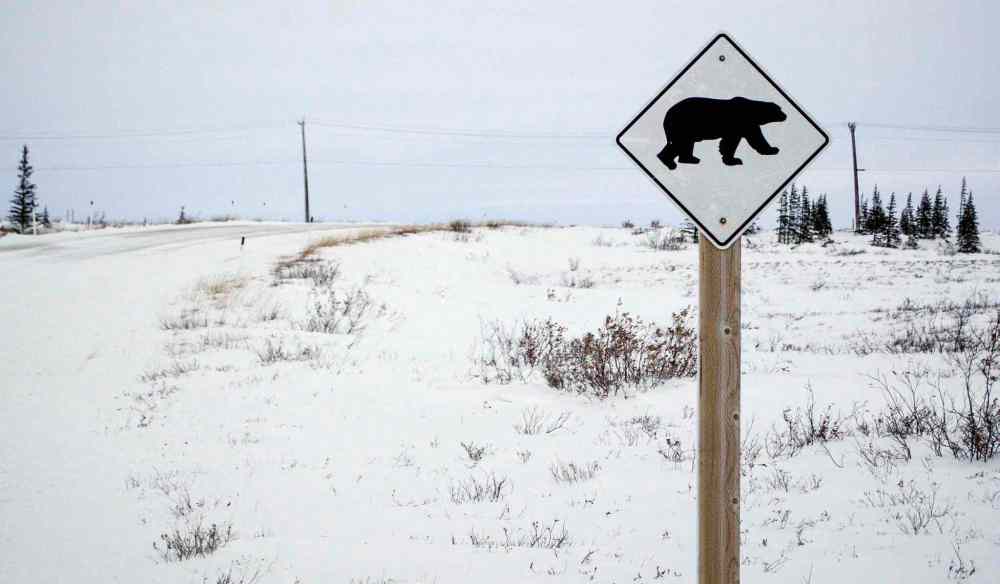
11 a.m.
Churchill has two main roads, one running south to the town’s water station on the Churchill River, and the other, which hugs the Hudson’s Bay coast.
It’s called Launch Road, because it was once a Cold War rocket range where American and Canadian forces sent 3,500 rockets into the sub-orbit, to study earth’s upper atmosphere.
The winding, gravel road curves around dark, snow-covered rocks and leaning spruce trees. Atop a hill sits an decommissioned radar base, topped by two crumbling white orbs that locals call “the golf balls.”
Ravens circle ahead and foxes dart through breaks in the trees. Save for two MTS workers inspecting a telephone pole, the 23-kilometre road is deserted.
The road ends at the Churchill Northern Studies Centre, a glistening blue-and-silver energy-efficient building, opened in 2011.
The non-profit research centre started in a concrete bunker in 1976, as the military wound down its operations. The centre’s parking lot is surrounded by space-age buildings, one disc-shaped and clad in white-and-red checkered siding, another a slanted cube of corrugated metal.
They harken back to a time when 4,000 people called Churchill home; just 899 did in last spring’s census.

The new, $19-million centre houses research labs, a cafeteria and 84 bunk beds. It offers tourists a chance to learn about polar bears and northern lights, and helps academics study fish health, or how climate change is altering plankton.
Churchill is an ecotone, meaning it straddles different ecosystems. The centre says that enables scientists to get a grasp on how changing weather patterns impact Arctic seas, the tundra and boreal forest.
“We’re in a really special location, and not just for tourism,” says interim executive director Stephanie Puleo, who supervises six full-time staff and 10 part timers.
Down the hall, one of them circles an aquarium, eyeing plants while taking notes on a clipboard. Another researcher plants seeds into an organic sponge filled with nutrients for a new hydroponic project aimed at growing vegetables for the town.
“We’re really happy to be here, as a leader in the North,” says Puleo.
11:30 a.m.
At the gas station, mechanic Kim Lang saunters through a wooden door toward Churchill’s only gas pump. He whacks the side of the pump, which starts clicking as it tallies fuel at $2.35 a litre.
“Everybody’s getting sick,” Lang says in a gruff tone, wiping his nose on a glove.
Back at the till, he rings through a customer while rubbing his left temple. He’s fixing a truck while running the pump and store, after two colleagues called in sick.
“Is it the food? I dunno,” he says. “Everybody’s gettin’ worn down here.”
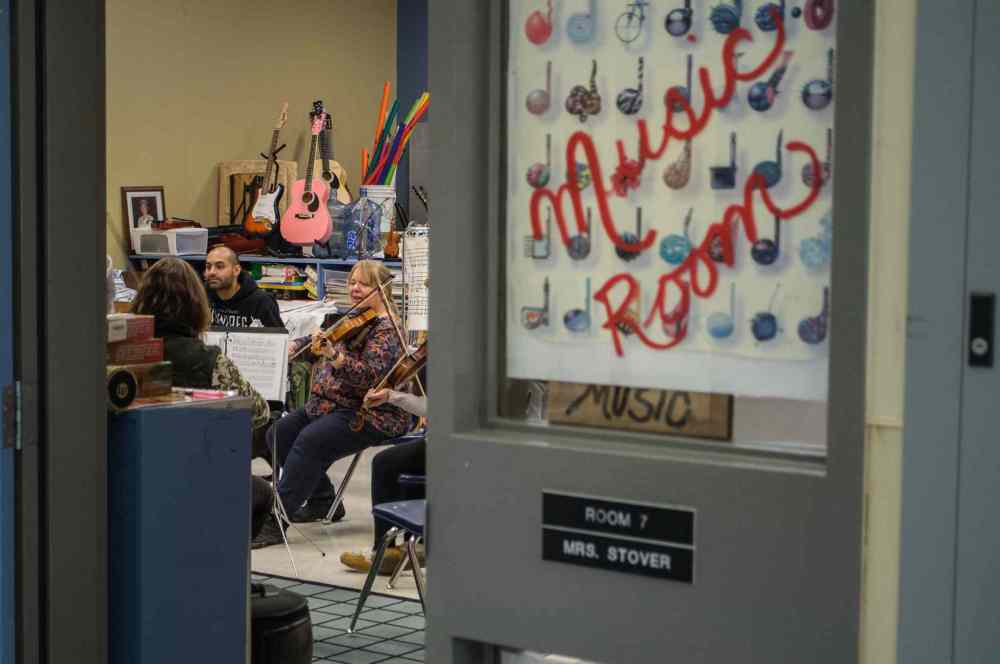
12:15 p.m.
It’s lunchtime at the local school and three pupils, two teachers and a maintenance worker gather in Joanne Stover’s classroom. They tune their fiddles and start playing holiday classics in preparation for the upcoming Christmas concert.
With fundraising help, Stover started a fiddling club, called Fiddlestix, a decade ago. Through Skype lessons and summer camps she learned how to play the instrument and now offers instruction to students in addition to her job as a social studies teacher.

The Duke of Marlborough School is named after John Churchill, the town’s namesake, a 17th century statesman who governed the Hudson’s Bay Company. He’s an ancestor of Britain’s wartime Prime Minister Winston Churchill.
Eddie Conrad plays notes on his guitar to help the student fiddlers keep pace. The Steinbach resident is nearing the end of his five-week teaching placement.
“People have a good life here,” he says. “There are lots of things to do, and the community is really tight.”
The school has lost about 40 students since it recorded 222 in June, though it’s unclear how many left as a result of the rail situation. There are 16 teachers, some of whom may be cut next year if admission drops.
That’s not front of mind for Stover.
“We are a resilient bunch,” she says. To her, the help of faraway strangers will help the town get back on its feet, and it’s up to the community to keep children focused on the future.
Donations are helping prepare an elders’ dinner, and hampers for the Christmas Cheer group. On Sunday, the Manitoba Metis Federation is flying a dozen musicians for a one-day concert with Stover’s group, and giving presents to each child.
Stover, a town councillor, arrived three decades ago from southern Ontario for a teaching job and hasn’t looked back.
“This is a place where you rely on each other, where you share the ups and downs,” she says. “Everybody needs to belong to something.”
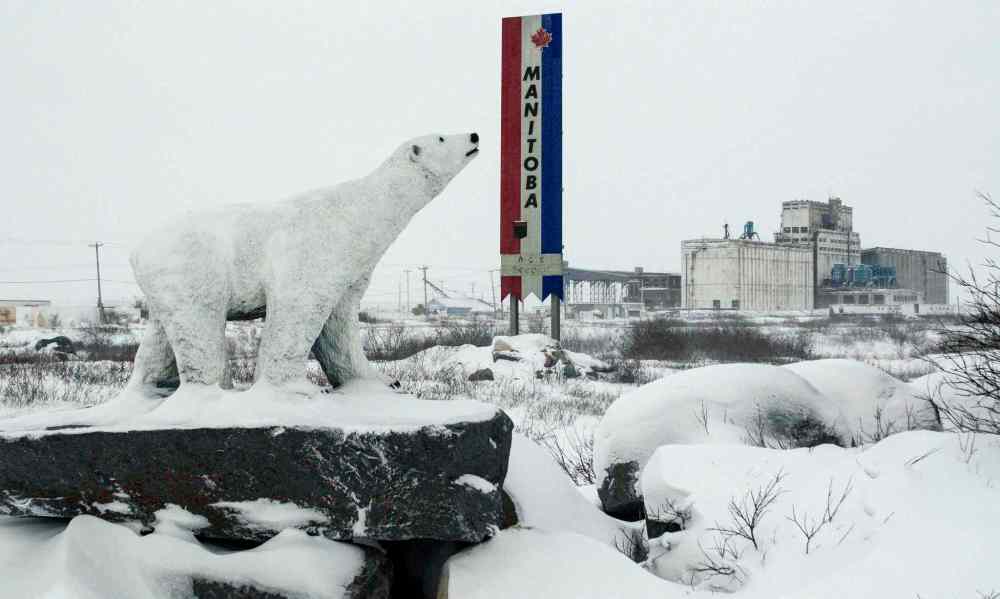
She often takes part in a beadwork group, where Indigenous elders share their craft.
She wears beaded gloves: a fiddle on the right hand, a piano on the left.
In the 2016 census, Churchill residents said they were just as likely to hold Indigenous heritage as they were to have a European background, and most claim roots in both. Stover says those statistics don’t often cross people’s minds.
“There’s just something about the North that makes us one,” she says.
1:30 p.m.
Back in town, a cashier tapes tinsel between checkout rows at the Northern store.
Northern is a one-stop shop that sells toys, school supplies, $13,700 snowmobiles and groceries. An ice-cream freezer is packed to the brim.
A middle-aged woman navigates the aisles, inspecting cans of this and boxes of that before dropping them into her basket. A can of Campbell’s Chunky soup costs $6.69. She puts it back on the shelf.
Canned corn is more reasonable, at $2.65, while a tin of mushrooms costs $2.89.
A four-litre jug of skim milk would costs more than $25, but federal and provincial subsidies bring the retail price down to $10.89. A jug of chocolate milk costs a dollar more.
A dozen dairy products and vegetables have a Government of Canada tag, informing shoppers that Ottawa is underwriting their groceries through the Nutrition North program. A poster in English and Cree explains the provincial AFFIRM program.
Both help bring the cost of a four-pack of tomatoes down to $10.59.
At the front sits three boxes of browning bananas, which cost a fourth less than the regular ones, which retail at $4.75 a kilogram. A clerk quips about how many loaves of banana bread could be made, if only flour weren’t so expensive.
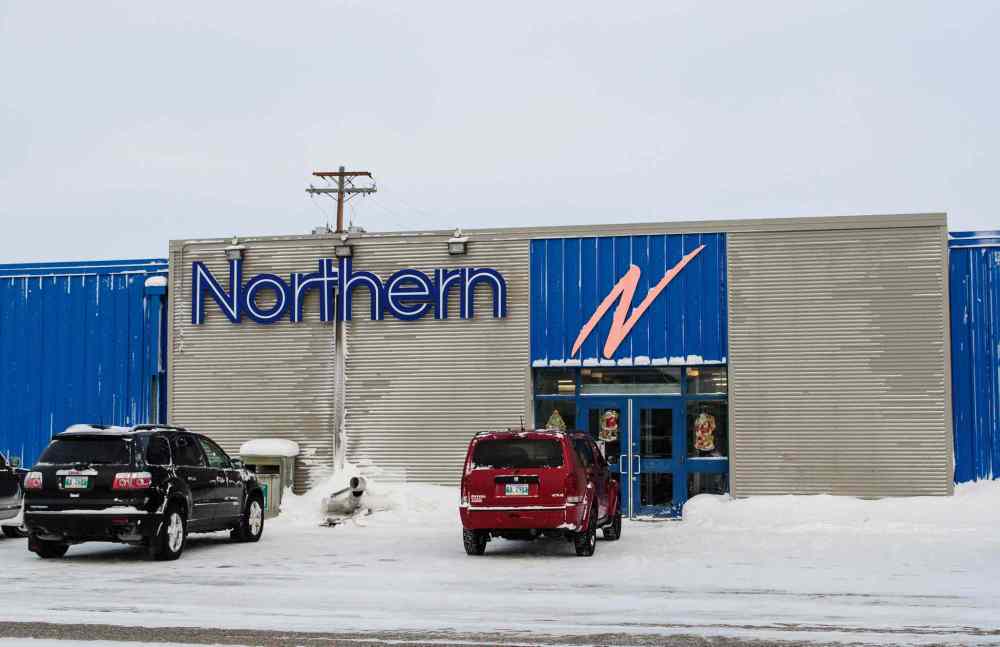
“It’s a real mix, the quality of the stuff we get up here.”
The North West Company, which owns the store, paid the added costs to fly in food — three times the price of rail shipments — until the federal subsidy kicked in during the summer. The store cleared out its back section to make room for a large shipment delivered by barge.
To restock the store, the company now uses the same plane intended for fly-in communities in Nunavut.
“Yes, people are frustrated with everything, but you also see the strength and resiliency of the people here,” says store manager Ian MacDonell, who has lived in remote communities across the North.
He moved to Churchill on one of the last trains before the May washout. A month later, residents started a food-share Facebook group, splitting cooked meals and giving away products nearing their expiry dates.
One street over from the Northern store sits the train station, a heritage building completed in 1930 and restored through a federal grant. Inside, a visitors centre walks tourists through local history of the military, wildlife and Indigenous groups.
Outside, blowing snow piles onto the four lines of rail tracks that lead to the port. Signs trumpeting federal and provincial economic plans are fraying at the edges.
3 p.m.
At St. Paul’s Anglican Church, April Lundie and Cheryl McCullough put the final touches on the Christmas tree before taking a seat in the wooden pews.
The church’s iron pre-fab frame arrived on a boat from England 125 years ago. It bears a stained-glass window dedicated to Arctic explorer Sir John Franklin, from his wife.
“My town is a special place, but I worry it’s going to die,” says Lundie.
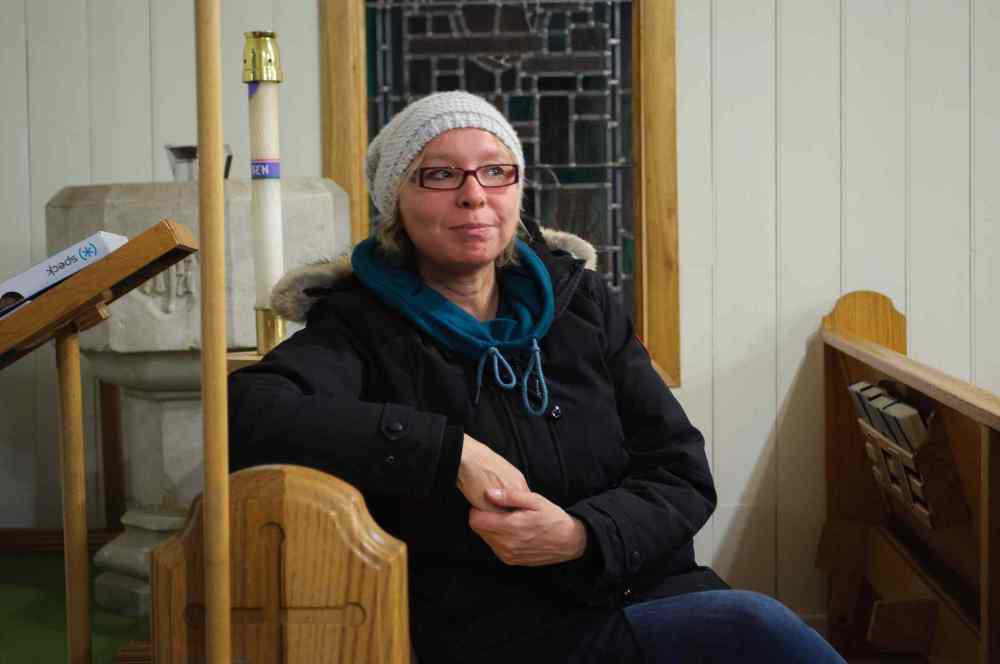
She’s a conservation worker who works all over the province, but returns home to Churchill almost every winter to take part in the Polar Bear patrol.
Patrollers on the outskirts of town use sounds in an effort to keep polar bears from getting up close and personal, and they also participate in capturing bears that make it over the border. Earlier this month, Lundie bid farewell to two orphaned cubs that were sent to the Assiniboine Park Zoo against the town’s wishes.
McCullough works at the hospital, Churchill’s largest employer since Omnitrax mothballed the port last year. As bad as that was, she says the realization several weeks ago that the rail line wouldn’t be repaired before freeze-up was a bigger blow to the community.
“It was devastating,” she says. “We lost our lifeline.”
McCullough worries for retired people, whose pension cheques aren’t keeping up with soaring food and fuel costs.
“There was hope,” she says, “but I think people lost hope.”
Lundie fears Churchill will follow Leaf Rapids, a Manitoba mining town that went from a population of 2,350 in 1981 to one-fifth that over the last three decades.
She’s hopeful that a “cat train” — a bulldozer-drawn sleigh convoy — opening next month will help relieve some of the pressure. It’s a costly and painfully slow way to move goods (about 10 km/h).
Without a working rail line, Lundie sees the town sputtering until “Band-Aid solutions” run out.
“I think that — I worry that it could happen,” she says. “I think it’s a real possibility.”
4:30 p.m.
Mike Spence drives towards the port as the sun sets over frozen Hudson Bay.
A painted wooden sign festooned with the word Manitoba frames the port, as does a plastic polar bear for tourists to pose next to. The words “Arctic Seaport” are peeling off, barely visible.
Through an open gate with numerous “no trespassing” signs, Spence drives toward the grain elevator. A brick building leans against an imposing, several storeys-high concrete tank, topped by an office with factory-style windows.
Spence weaves between the black metal beams and cranes, recalling the days when ships from across the world docked here. A single truck moves around the port; the driver waves from behind the steering wheel.

Though the port’s official shipping season is 14 weeks — from July 15 to Halloween — the bay has, year by year, taken longer to freeze and the spring melt happens earlier; there are now two additional weeks without ice on both ends. Spence has tried to get shipping and insurance companies to lengthen port season, but has had limited success.
Many believe climate change is responsible for the extreme snowfall and too-quick melt that washed out parts of the rail line. Spence says a longer shipping season at an operational port could mitigate some of the hardship of the last seven months and offer some benefit to the community.
“Some people don’t see the potential here,” he says, shaking his head. “This is Canada’s only northern port.”
Spence is co-leading the now-unified local group attempting to take ownership of the rail line and port.
“This is a real opportunity,” he says. “Let’s make something positive out of this.”
At the mouth of the Churchill River, snow dunes look like unmoving waves. “Frozen in time,” he says.
6 p.m.
After serving a grand total of four customers, Rhoda de Meulles closes up her Home Hardware franchise for the day.
She laid off 12 full-time employees during the summer when shipping costs skyrocketed and her client base in Nunavut collapsed.
Now, she runs the store with her husband Dale and close friend Michelle Beaton.
“We had to let everybody go because we’re not really selling anything,” she says; three or four customers now is the new normal.
“It’s been very hard.”
When the rail line ruptured, orders went from a one-week turnaround to an ordeal requiring two months’ notice. She faced two choices: close the store, or ship up an entire year of products in one boat from Montreal, from suppliers she’d never used before.
“It hurt us that we couldn’t support our Winnipeg (businesses) because they helped us all those other years, and then my money actually went to Montreal,” said de Meulles, who has run the store for 14 years. “That really bothered me, because we are Manitobans.”
Instead of the typical 200 crates she ships up to Nunavut, just seven left the port this year. In the town, no one’s doing construction.
“Business isn’t the greatest, but it’s keeping the doors open.”
She finds solace in two Icelandic horses that can withstand the cold. One is hers, Beaton owns the other.
“Going to the horses, getting hugs and kisses, it helps brighten up my day,” she says.
The pair have spent $17,000 to have a winter’s worth of hay for the two horses shipped by air. The same quantity has cost them $3,600 by rail. A crowdfunding effort raised $1,410; the rest came from de Meulles’ RRSP.
“One day at a time, that’s what we’re doing right now,” she says. “That’s the only thing we can do.”

7 p.m.
Pop music echoes through the halls of the town complex. The sprawling, multi-level building includes a gym, hockey rink, bowling alley, basketball court, library and cafeteria.
The town waived virtually all recreational fees this month, in an effort to keep cash-strapped residents active.
Downstairs, children — bundled up to their eyes — are herded from the parking lot into change rooms by their parents.
Upstairs, there’s a large wooden polar bear with a red tongue — a slide — coming out its mouth.
The complex hugs the shore of Hudson Bay. There’s a faint string of green northern lights glowing in the sky. Below, an Inukshuk and an old boat are covered in snow.
8 p.m.
Longtime musher David Daley helps his protegé Justin Allen cut up a moose for their sleigh dogs.
They first honour the moose with a pipe song and tobacco, before skinning, quartering and butchering the meat. The process takes three days.
Allen arrived in Churchill more than five years ago, while on a three-month trip from New Brunswick to Vancouver, where the hair stylist was hoping to land a job working in the film industry.
“I fell in love with the dogs,” Allen says. “You learn to have an individual relationship with each dog. When you look after them, they look after you.”

Allen had some limited hunting experience growing up, but says he’s gained a new appreciation for animals.
“The hunt carries more meaning,” he says. “It’s that relationship between life and death; for people to live and prosper and be nurtured, an animal has to be sacrificed.”
Daley was raised in Churchill, and has seen people settle from across Canada.
“What attracts people is the freedom. You can be who you want to be. You can reinvent yourself,” he says. “This is a place like no other place.”
Allen is crowdfunding for his next adventure, moving back to New Brunswick by sleigh. On Jan. 15, he’ll take his 12 dogs on the 3,000-kilometre journey east to start an eco-tourism business in his home province.
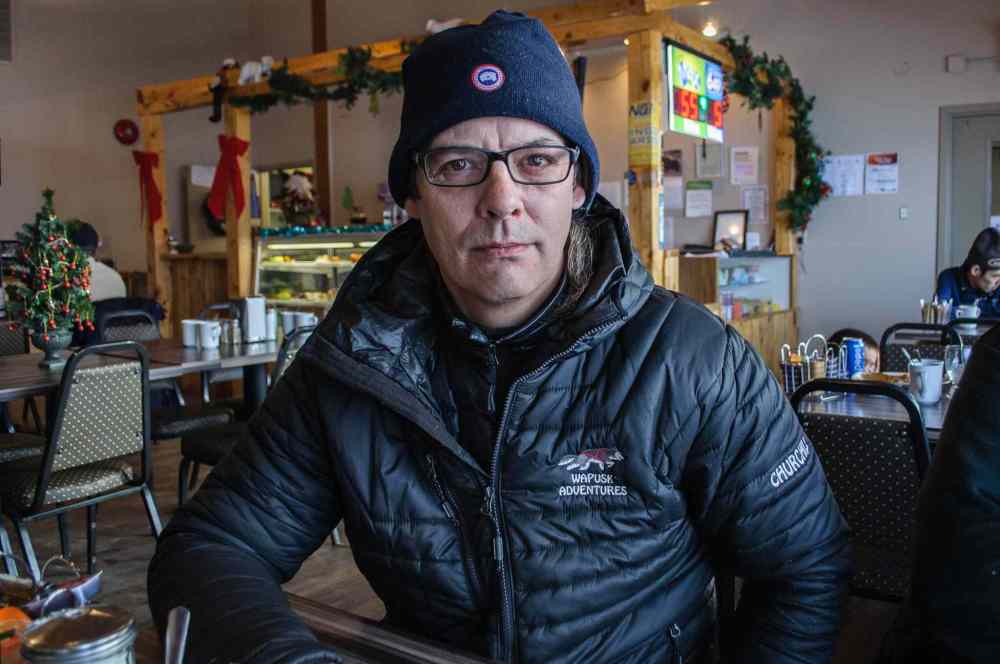
He’ll be helped by a truck with a sleeping trailer, individual bed boxes for the dogs and a snow machine to help carve his path. The dogs will wear leggings, booties and jackets, but they’ll make the entire trip.
His estimated $60,000 journey has dropped to $45,000, thanks to hunting and donations. He’ll be crossing reserves, and is making an effort to emulate the respect for the land central to how First Nations have practised mushing.
“I just want to be 100 per cent positive, and show the love and healthy aspects of positive living.”
9 p.m.
Town employee Patricia Kandiurin keeps busy.
Since the rail line was knocked out, she’s helped co-ordinate sponsorships and donations. She spends her spare time filling backpacks with school supplies, recording students’ shoe sizes and delivering food to the students’ breakfast program.
She also delivers food to single moms and others in need. Some tell her they’ve skipped taking medication in order to pay for food.
Kandiurin has volunteers leave donations on her front porch, which have poured in; at times the space has been crammed with shoes or turkeys. She started thinking about having the porch enlarged last spring; the $500 estimate then has now tripled.
While everyone in the community has been hit hard by the rail disruption, she feels especially bad for the schoolchildren.
In the past, she took her own kids down the rail line to Thompson’s summer Nickel Days fair, and sports teams travelled by rail to Gillam, where they could board buses to get to tournaments.
Kandiurin is helping plan a student trip to Italy in 2019; they’ve pulled off ambitious fundraising goals before.
“I want to motivate them to work towards something,” she says.
But she admits that the volunteer work distracts her from her own worries.
“I didn’t look at prices at first. I used to think I wasn’t affected, but now I admit that we are.”
With her husband, she’s paid for a home, and both have stable jobs; she’s a support officer, co-ordinating logistics for the town. But the cost of living has her worr ied about the line of credit they took out for their daughter’s University of Manitoba degree.
“I’ve thought about moving south like everyone else, but what’s the point?” she says. “I hate Omnitrax. When all this is said and done, I’m going to take a doll, put an Omnitrax tuque on it and burn it.”
She signs, looking down at her clenched fist. She opens her hand down and places it flat on the table.
“We need our rail line back.”
dylan.robertson@freepress.mb.ca

































